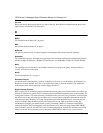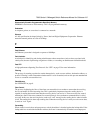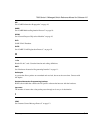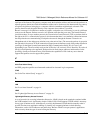
7000 Series L3 Managed Switch Reference Manual for Software v2.0
Glossary C-7
D
DAPI
See “Device Application Programming Interface” on page 7.
Device Application Programming Interface
DAPI is the software interface that facilitates communication of both data and control information between
the Application Layer and HAPI, with support from System Support.
DHCP
See “Dynamic Host Configuration Protocol.” on page 8.
Differentiated Services.
Diffserv is a protocol for specifying and controlling network traffic by class so that certain types of traffic
get precedence - for example, voice traffic, which requires a relatively uninterrupted flow of data, might get
precedence over other kinds of traffic. Differentiated Services is the most advanced method for managing
traffic in terms of what is called Class of Service (CoS). Unlike the earlier mechanisms of 802.1P tagging
and Type of Service (ToS), Differentiated Services avoids simple priority tagging and depends on more
complex policy or rule statements to determine how to forward a given network packet. An analogy is made
to travel services, in which a person can choose among different modes of travel - train, bus, airplane -
degree of comfort, the number of stops on the route, standby status, the time of day or period of year for the
trip, and so forth. For a given set of packet travel rules, a packet is given one of 64 possible forwarding
behaviors - known as per hop behaviors (PHBs). A six-bit field, known as the Differentiated Services Code
Point (DSCP), in the Internet Protocol (Internet Protocol) header specifies the per hop behavior for a given
flow of packets. Differentiated Services and the Class of Service approach provide a way to control traffic
that is both more flexible and more scalability than the Quality of Service approach.
Diffserv
See “Differentiated Services.” on page 7.
Distance-Vector Multicast Routing Protocol.
DVMRP is a distance vector routing protocol used between routers in an intranet. This hop-based protocol
describes a method of building multicast trees from the multicast source to all the receivers (or leaves) of the
tree.
DNS
Short for Domain Name System (or Service), an Internet service that translates domain names into IP
addresses.
Because domain names are alphabetic, they're easier to remember. The Internet however, is really based on
IP addresses. Every time you use a domain name, therefore, a DNS service must translate the name into the
corresponding IP address. For example, the domain name www.example.com might translate to


















